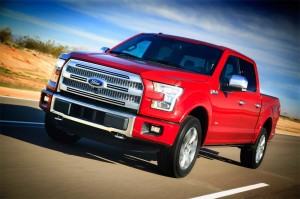Faced with tough new fuel economy standards that will climb to 54.5 mpg over the next decade, “lightweighting” has become the strategy of choice for automotive designers and engineers, according to a new survey.
The upcoming launch of the “aluminum-intensive” Ford F-150 pickup is just one of the many examples of how manufacturers are putting their vehicles on a diet and gaining significant improvements in fuel economy as a result.
“The automotive industry is racing to develop safe, fun and affordable vehicles that are much more fuel efficient and produce far fewer emissions,” said Pat Lindner, president of DuPont Performance Polymers, which conducted the survey that was released during the annual Management Briefing Seminars in Traverse City, Michigan.
Of the nearly 900 industry insiders polled, 66% anticipated that, if anything, the 2017-2025 Corporate Average Fuel Economy, or CAFE, standards could get even more stringent as a result of an upcoming mid-term review.
(New Jaguar XE to adopt a lightweight aluminum design. Click Here for more.)
Manufacturers are looking at all sorts of options to get to their targets. They’re opting for more advanced engine and transmission technologies, as well as improved aerodynamics, and alternative powertrains – whether hybrid, electric or even hydrogen – are expected to become a greater part of the new vehicle mix.
But lightweighting is gaining ground rapidly, and for good reason considering the general rule of thumb is that fuel economy increases by about 1 mpg for every 100 pounds of mass a vehicle loses.
That was a big selling point when Ford planners decided to switch from steel to aluminum for the body of the next generation Ford F-150 pickup truck. Production of the full-size is expected to begin at the end of August, Ford officials said recently. And the maker is expected to migrate to aluminum for heavy-duty models, like the Super Duty, over the next several years.
Ford’s switch is being closely watched across the industry. Fiat Chrysler chief executive officer Sergio Marchionne said this week that he was watching developments related to the truck very carefully and indicated it could influence future decisions about Chrysler’s Ram line.
(Study says more pickups will switch to aluminum. Click Here for the story.)
The U.S. Environmental Protection Agency standards require, on an average industry fleet-wide basis, that makers cut the emission of CO2 down to 163 grams per mile by model year 2025, which would be equivalent to 54.5 mpg if this level were achieved solely through improvements in fuel efficiency.
The EPA in April released a report on vehicle greenhouse gas emissions that concluded “automakers are off to a good start,” and the U.S. National Highway Traffic Safety Administration in June published its Summary of Fuel Economy Performance report that shows auto manufacturers project fleet production will come in at just above 34 mpg for 2014.
Automotive designers and engineers are looking for technologies they are working on to lower emissions and improve fuel economy, said Lindner, and half the time you’ll hear them use the specific term “lightweighting,” according to the results of the DuPont survey.
Also topping the list are engine efficiency programs, vehicle electrification and the adoption of diesel power, the survey said.
(Ford investigating fire that destroyed aluminum F-Series Super Duty during testing. Click Here for more.)
“We still have a long way to 54.5 miles per gallon in 2025,” the DuPont executive said. “This is a marathon – not a sprint. Clear strategies need to be set, checkpoints need to be established and the most effective tool we have in this race is collaboration.”
Results of the fourth annual survey also found that while aluminum is expected to be relied on heavily to meet new CAFE standards, plastics, advanced composites and multi-material, or hybrid, solutions are also being integrated into the designs of future vehicles.
Jeff Sternberg, director of DuPont Automotive Technology, said, “There is no silver bullet – every part and vehicle system faces a different set of requirements – but it is pretty clear that the automotive design and engineering community needs more support from advanced materials suppliers to reduce vehicle weight.”
(Paul A. Eisenstein contributed to this report.)


Unless the majority of new vehicles are 100% produced from Unobtainium, they will not meet the absurd 54.5 mpg CAFE requirement. There is absolutely NO scientific basis for the 54.5 mpg number mandated by DC politicians. They just pull this stuff from their orifice.